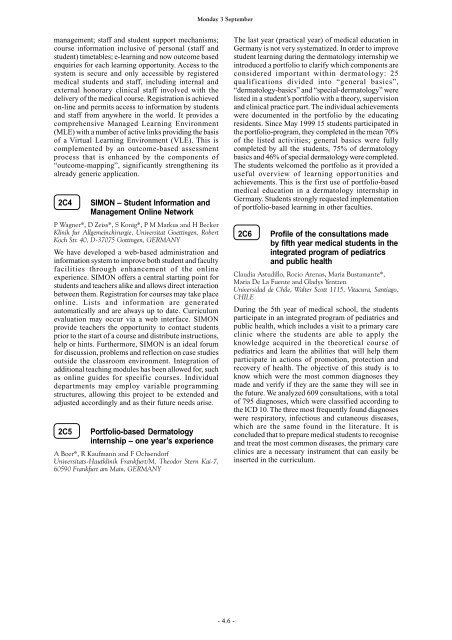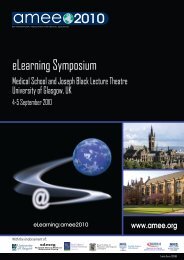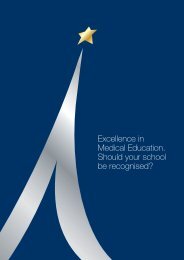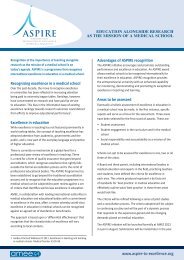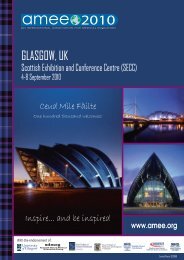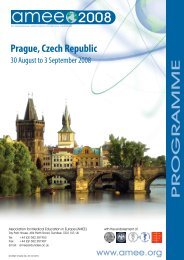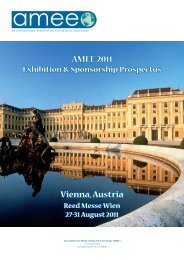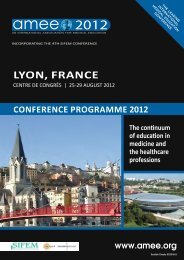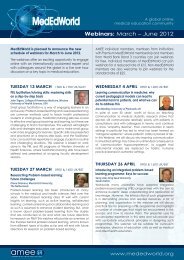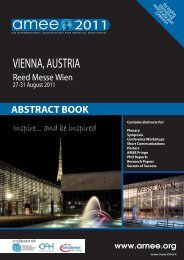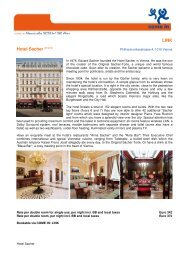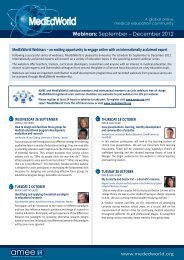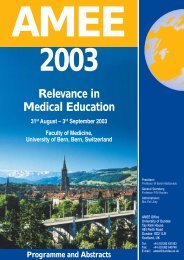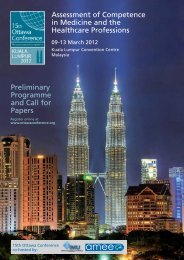AMEE Berlin 2002 Programme
AMEE Berlin 2002 Programme
AMEE Berlin 2002 Programme
Create successful ePaper yourself
Turn your PDF publications into a flip-book with our unique Google optimized e-Paper software.
management; staff and student support mechanisms;<br />
course information inclusive of personal (staff and<br />
student) timetables; e-learning and now outcome based<br />
enquiries for each learning opportunity. Access to the<br />
system is secure and only accessible by registered<br />
medical students and staff, including internal and<br />
external honorary clinical staff involved with the<br />
delivery of the medical course. Registration is achieved<br />
on-line and permits access to information by students<br />
and staff from anywhere in the world. It provides a<br />
comprehensive Managed Learning Environment<br />
(MLE) with a number of active links providing the basis<br />
of a Virtual Learning Environment (VLE). This is<br />
complemented by an outcome-based assessment<br />
process that is enhanced by the components of<br />
“outcome-mapping”, significantly strengthening its<br />
already generic application.<br />
2C4 SIMON – Student Information and<br />
Management Online Network<br />
P Wagner*, D Zeiss*, S Konig*, P M Markus and H Becker<br />
Klinik fur Allgemeinchirurgie, Universitat Goettingen, Robert<br />
Koch Str. 40, D-37075 Gottingen, GERMANY<br />
We have developed a web-based administration and<br />
information system to improve both student and faculty<br />
facilities through enhancement of the online<br />
experience. SIMON offers a central starting point for<br />
students and teachers alike and allows direct interaction<br />
between them. Registration for courses may take place<br />
online. Lists and information are generated<br />
automatically and are always up to date. Curriculum<br />
evaluation may occur via a web interface. SIMON<br />
provide teachers the opportunity to contact students<br />
prior to the start of a course and distribute instructions,<br />
help or hints. Furthermore, SIMON is an ideal forum<br />
for discussion, problems and reflection on case studies<br />
outside the classroom environment. Integration of<br />
additional teaching modules has been allowed for, such<br />
as online guides for specific courses. Individual<br />
departments may employ variable programming<br />
structures, allowing this project to be extended and<br />
adjusted accordingly and as their future needs arise.<br />
2C5 Portfolio-based Dermatology<br />
internship – one year’s experience<br />
A Boer*, R Kaufmann and F Ochsendorf<br />
Universitats-Hautklinik Frankfurt/M, Theodor Stern Kai-7,<br />
60590 Frankfurt am Main, GERMANY<br />
Monday 3 September<br />
- 4.6 -<br />
The last year (practical year) of medical education in<br />
Germany is not very systematized. In order to improve<br />
student learning during the dermatology internship we<br />
introduced a portfolio to clarify which components are<br />
considered important within dermatology: 25<br />
qualifications divided into “general basics”,<br />
“dermatology-basics” and “special-dermatology” were<br />
listed in a student’s portfolio with a theory, supervision<br />
and clinical practice part. The individual achievements<br />
were documented in the portfolio by the educating<br />
residents. Since May 1999 15 students participated in<br />
the portfolio-program, they completed in the mean 70%<br />
of the listed activities; general basics were fully<br />
completed by all the students, 75% of dermatology<br />
basics and 46% of special dermatology were completed.<br />
The students welcomed the portfolio as it provided a<br />
useful overview of learning opportunities and<br />
achievements. This is the first use of portfolio-based<br />
medical education in a dermatology internship in<br />
Germany. Students strongly requested implementation<br />
of portfolio-based learning in other faculties.<br />
2C6 Profile of the consultations made<br />
by fifth year medical students in the<br />
integrated program of pediatrics<br />
and public health<br />
Claudia Astudillo, Rocio Arenas, Maria Bustamante*,<br />
Maria De La Fuente and Gladys Yentzen<br />
Universidad de Chile, Walter Scott 1115, Vitacura, Santiago,<br />
CHILE<br />
During the 5th year of medical school, the students<br />
participate in an integrated program of pediatrics and<br />
public health, which includes a visit to a primary care<br />
clinic where the students are able to apply the<br />
knowledge acquired in the theoretical course of<br />
pediatrics and learn the abilities that will help them<br />
participate in actions of promotion, protection and<br />
recovery of health. The objective of this study is to<br />
know which were the most common diagnoses they<br />
made and verify if they are the same they will see in<br />
the future. We analyzed 609 consultations, with a total<br />
of 795 diagnoses, which were classified according to<br />
the ICD 10. The three most frequently found diagnoses<br />
were respiratory, infectious and cutaneous diseases,<br />
which are the same found in the literature. It is<br />
concluded that to prepare medical students to recognise<br />
and treat the most common diseases, the primary care<br />
clinics are a necessary instrument that can easily be<br />
inserted in the curriculum.


